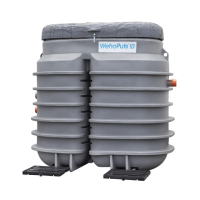
Do you have a question about the Uponor WehoPuts Series and is the answer not in the manual?
| Brand | Uponor |
|---|---|
| Model | WehoPuts Series |
| Category | Water System |
| Language | English |
The WehoPuts plant is a bio-chemical domestic wastewater treatment system for year-round use.
Safety precautions for handling the plant, including locking the lid and using protective equipment.
Lists materials that can clog or damage the treatment plant pumps and stop the process.
Describes the stages: Wastewater batch accumulation, Aerating and chemical feed, Nitrogen removal and settling, Removal of treated water.
Instructions for transporting, handling, and storing the treatment plants upright, including packed items.
Requires a plan for construction, consultation with designers, and consideration of local regulations.
Key planning issues include location, connections, discharge/overflow, freezing prevention, and storm water.
Verify plant equipment is not damaged during transport and remove anchor packaging.
Emphasizes work safety, trench leveling, mechanical compression, and subsurface drains.
Details anchoring procedures using plates and rods, especially important for clay or high groundwater.
Install anchor rods through holes in the bottom ribs on each side of the unit.
Install anchor rods through holes at the bottom of the tank and install anchor plates.
Instructions for connecting inlet, overflow, and discharge pipes, noting spigot usage.
Steps for installing the ventilation pipe, passing the signal lamp cable, and attaching the lamp.
Details fixed land installation, connection to the single-phase socket, and grounding via the main board.
Instructions for insulating the plant and pipes with specific thickness and slant.
Steps for filling the trench, shaping the ground, installing interim covers, and locking the plant.
Inspects pipe/electrical connections, and checks for sand/stones on tank bottoms after installation.
Instructions on releasing transfer and sludge pumps from transport brackets.
Refers to section 5.2 for instructions on filling the chemical container.
Steps to install the SIM card and initialize the GSM modem for remote monitoring.
Instructions for opening the rail, inserting the SIM card, and connecting power.
Explains how to register the mobile phone number for alarm messages via software.
Describes turning on the main power and the plant entering standby mode.
Notes that sludge bag is default, vacuum truck removal requires software setting change.
Refers to section 5.3.1 for sludge bag installation instructions.
Describes the control unit for operation, progress monitoring, and settings like language and sludge removal.
Explains how the control unit display shows plant status, with text browsed using arrow keys.
Details how to access and change operational settings via the software menu, including language, sludge removal, and alarms.
Explains how to acknowledge alarms and reminders using the Enter key or specific number keys.
Describes how the GSM modem allows remote control and monitoring via mobile phone using SMS.
Regular monitoring of the signal lamp, control unit display, and compressor for proper functioning.
Instructions for safely filling the chemical tank, including safety precautions and recommended quantities.
Describes sludge removal options: using a sludge bag or a vacuum truck.
Steps for installing and replacing the sludge bag, including maintenance intervals.
Recommends composting sludge bags with organic waste and provides guidelines for proper composting.
Practical advice on using composters, additives, and handling sludge bags for composting.
Instructions for vacuum truck emptying, including setting activation and settling tests.
Detailed instructions on performing a sludge settling test using a measuring glass to determine vacuum truck needs.
Explains that sampling should be done by professionals and describes sample taking locations and timing.
Discusses the importance of pH and how to adjust it using lime, with safety warnings.
Specifies the correct type of lime (ground limestone crush) and warns against hydrated lime.
Details lime dosing, aeration during liming, monitoring pH levels, and dosage frequency.
Indicates the plant has no alarms.
Indicates a malfunction requiring service procedures and display inspection.
Indicates a malfunction that has stopped the process and requires service.
Describes alarms and reminders identified by the signal lamp and control unit display.
Instructions on how to acknowledge alarms and reminders using the control unit.
Steps to take when equipment malfunctions, including disconnecting and testing ground fault switches.
Explains how to use the X6 service socket to test plant equipment by moving plugs.
Mentions testing equipment operations via logic operation settings menu and IO testing.
Describes how the control unit remembers the interrupted process stage and resumes after power restoration.
Addresses common malfunctions related to cleaning processes like odors and foaming.
Addresses causes of noticeable odors, sludge inspection, and testing aeration.
Explains foaming during startup and its potential causes, advising to contact service if persistent.
Steps to check sludge pump operation and test it via the software or service socket.
Covers the recommended annual service visit by an authorised partner to inspect functional units.
Instructions for cleaning pumps and level switches yearly or as needed, with safety precautions.
Detailed steps for cleaning the transfer pump, including lifting it out and checking the blade wheel.
Step-by-step guide to cleaning the emptying pump and sludge pump, including removing them and checking for clogging.
Instructions for cleaning the three level switches by removing dirt and rinsing if necessary.